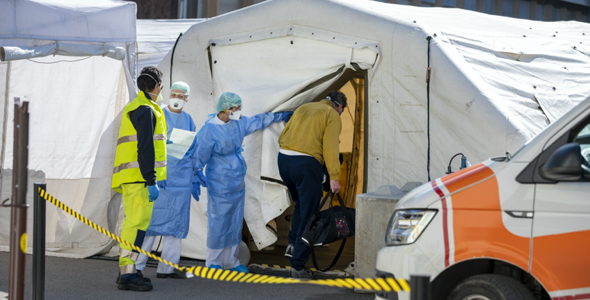By the bioMérieux Connection Editors
Healthcare professionals are risking their personal health to help treat patients and fight the virus, and sometimes they must make difficult triage decisions in order to efficiently provide patient care to those who need it most. Triaging is the process of sorting people based on their need for immediate medical treatment, taking into account their chance of benefiting from such care. It is critical for properly distributing resources and helping to ensure that patients receive appropriate care for their condition.
The COVID-19 pandemic has led to severe shortages of many healthcare tools: personal protective equipment (PPE) such as face masks and gloves, and items essential to patient care including beds and ventilators. These shortages, combined with the fact that it is possible for patients with mild cases to recover from COVID-19 at home, require hospital staff to triage incoming patients, determining who needs to be admitted to the hospital and who can return home. Triaging is also necessary to protect the health of staff and other patients within the hospital.
Many health systems are implementing vetting processes, such as screening patients with COVID-19 symptoms in alternate locations, like tents or trailers, before these patients enter the hospital.
“In the same vein that we are practicing social distancing out in the public, we want to try and keep the patients that sound as though they do not have COVID symptoms away from patients that potentially may have COVID symptoms,” Meghan Hilliard, the regional director of emergency services at Backus Hospital in Norwich, Connecticut, stated in a recent interview.
However, figuring out who does and does not have COVID-19 has often been challenging. A survey of hospitals in late March found that many health systems across the country are ill-equipped to deal with COVID-19 patients, in large part due to severe shortages of tests and extended waits for results. While many commercially-produced molecular tests have received Emergency Use Authorization from the FDA, global supply chain challenges remain. Health systems like Mayo Clinic and UPMC have been able to develop their own COVID-19 tests as an additional measure to help address supply shortages and triage patients.
The survey also reported that some hospitals are starting to test patient samples in-house, rather than send out for testing at commercial or public labs. Jane Hata of the Florida Mayo Clinic’s Department of Laboratory Medicine and Pathology reported to Healthcare Dive that more rapid results are helping physicians determine who needs to self-quarantine, who may have been exposed, and which patients can be moved to free up rooms for those who test positive for the virus.
Besides molecular tests, clinicians and researchers have been exploring additional diagnostic tools. For example, a team of clinicians who used lung ultrasounds on the front line recently released the first protocol for use to help standardize the practice. The pandemic struck hard in Spain and Italy, and clinicians found themselves hard-pressed to quickly understand whether patients were harboring more serious lung involvement, which could indicate the presence of pneumonia.
While lung ultrasounds are not universally accepted as a tool for triaging COVID-19 patients, the authors found the method to be helpful in Italy, especially when ultrasounds came back negative. “This patient may have COVID-19 of course, but they do not have pneumonia, and they can be treated at home, awaiting the result of the swab test. And this is useful because you can reduce the burden in the emergency department,” said Dr. Giovanni Volpiecelli of the University Hospital San Luigi Gonzaga.
What is known about COVID-19 evolves rapidly, so it’s hard to say exactly how triage processes will develop over time. One thing is for certain: triaging will remain extremely critical in protecting healthcare workers and allocating supplies worldwide.
Opinions expressed in this article are not necessarily those of bioMerieux, Inc.



